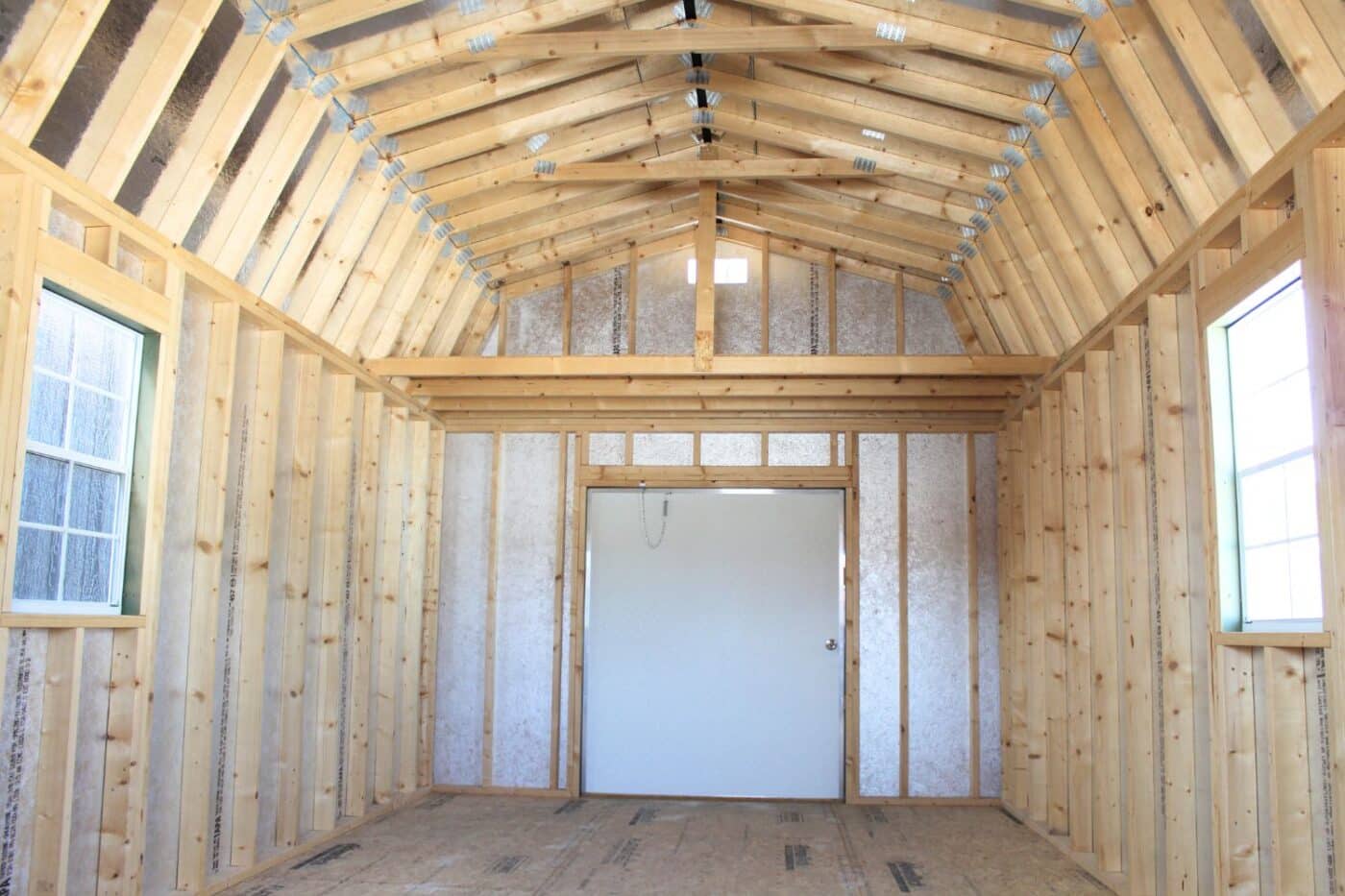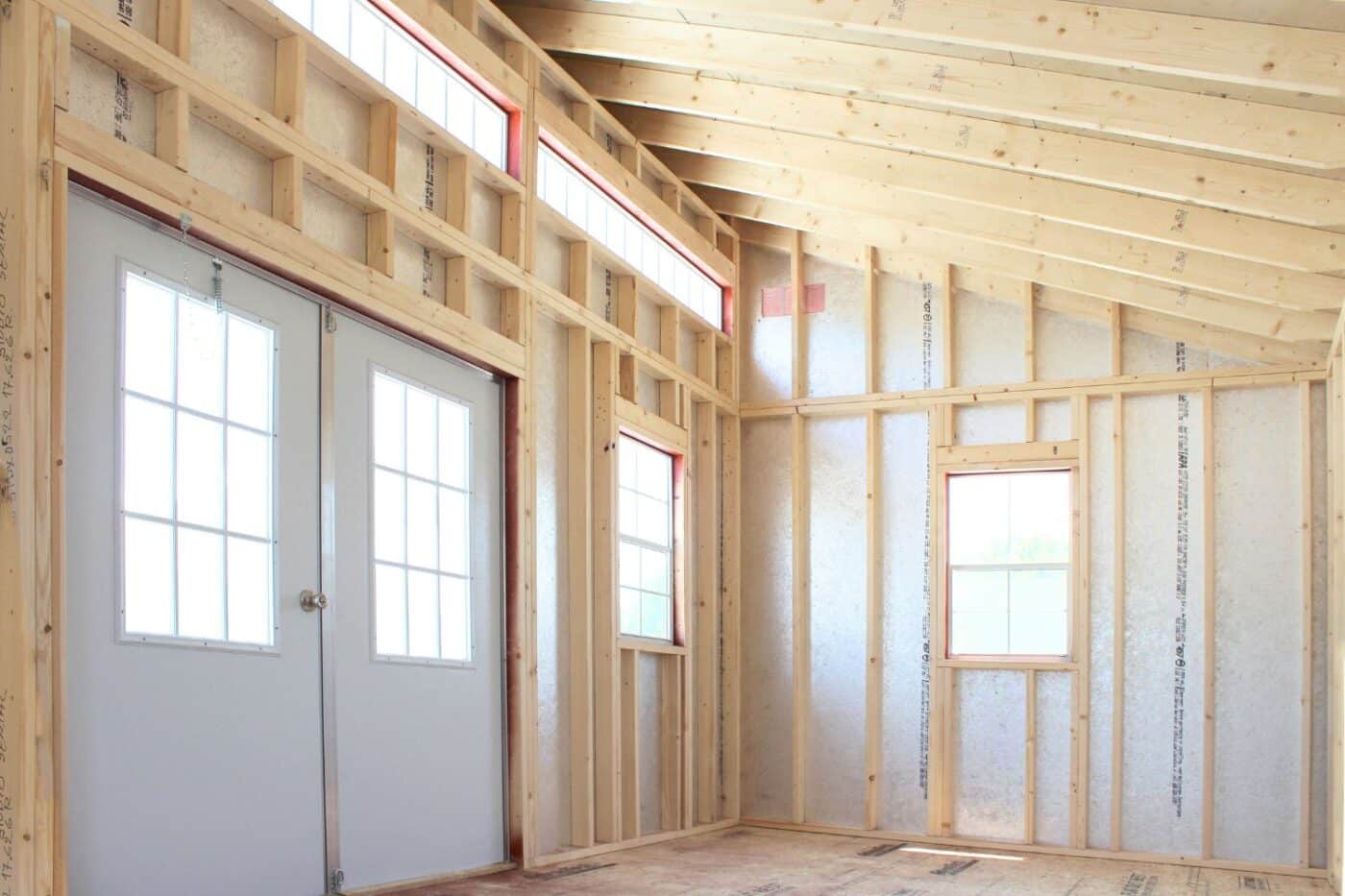JESUS IS COMING SOON!
Save 12% on 2023 models! Click Here!
Save 12% on 2023 models! Click Here!
Save 12% on 2023 models! Click Here!
Save 12% on 2023 models! Click Here!

If you use your shed for more than just storing tools, whether it’s a workshop, hobby space, or small retreat, then insulation and air sealing can make a big difference. One of the most effective ways to insulate and seal a shed roof is with rigid foam insulation.
This guide walks you through exactly how to air seal shed roof with rigid foam, using straightforward steps and commonly available materials. Whether you’re building new or upgrading an existing structure, this process can help keep your shed more comfortable and energy-efficient year-round.

A properly sealed roof helps block air leaks, which can cause temperature swings, drafts, and even moisture buildup. When a roof isn’t sealed, warm air can escape in the winter, and hot air can pour in during the summer, making the shed uncomfortable or unusable.
Air sealing also protects against condensation, something that’s especially important if you store electronics, tools, or anything sensitive to humidity. By sealing up the roof, you extend the life of your shed while making it a more functional space overall.
An air-sealed shed roof also plays a key role in energy efficiency. If you’ve installed a mini-split, space heater, or window AC unit in your shed, a sealed roof keeps your conditioned air from slipping through cracks or seams in the roof deck.
And lastly, if you’re planning to finish your shed interior for living or working, air sealing should be at the top of your checklist. It’s not just about comfort, it’s about protecting your investment.
Rigid foam insulation comes in large panels, often 4 feet by 8 feet, and is known for its durability, moisture resistance, and high R-value per inch. It’s a popular choice for shed and outbuilding insulation because it’s easy to work with, lightweight, and long-lasting. There are a few common types of rigid foam you might encounter:
What makes rigid foam especially effective for air sealing is its solid structure. Unlike fiberglass batts, which can compress or sag, foam boards maintain their shape and can be tightly fitted into roof bays or laid flat against the roof deck.

Before getting started, it’s important to have everything on hand to avoid unnecessary delays. Here’s a checklist of what you’ll need:
Start by taking precise measurements of the area you’ll be insulating. If you’re working between roof rafters, measure the space between them to determine the width of each panel. If you’re covering the underside of the roof deck, measure the entire length and width.
Use a straight edge and utility knife to cut the foam boards to size. Cut slowly to avoid jagged edges and ensure a clean, snug fit. Always err on the side of a tighter fit, as small gaps must be sealed later with spray foam.
If your shed has any obstructions like light fixtures, vents, or wiring, mark and cut around these as you go. Labeling your panels before cutting can help you stay organized, especially if you’re cutting several boards at once.
Once your panels are cut, it’s time to install them. You have two main options for placement:
Apply adhesive to the back of each panel before pressing it into place. Hold the panel for a few seconds to let the adhesive grip. Work your way across the roof, one section at a time. Use temporary bracing or fasteners if needed to keep the panels in place while the adhesive cures.
After the foam panels are installed, inspect the seams between them. Use spray foam or a high-quality caulk to fill any gaps. Pay extra attention to corners and edges, where air leaks are most likely.
Next, apply foil tape or specialized seam tape over all panel joints. This creates a continuous air barrier and improves the overall airtightness of the insulation layer. Press the tape firmly to ensure full adhesion.
If you’re using more than one type of foam or combining it with other insulation, make sure your sealant and tape are compatible with all materials involved.
This sealing step is what transforms basic insulation into a true air sealing system, so don’t rush it.
Depending on your climate, shed use, and insulation goals, adding a second layer of rigid foam may be worth the extra effort.
A second layer allows you to:
Install the second layer just like the first, using adhesive and foil tape. If you plan to finish the interior with drywall or wood paneling, install furring strips over the foam and screw your wall finish into them.
The added thickness may also allow for the use of thicker insulation boards, giving you more thermal performance per square foot.
Once your shed roof is sealed and insulated, some maintenance and thoughtful planning will keep it performing well for years. Here are some useful tips:
Different climates require different insulation values. In colder areas, aim for a higher R-value. For sheds that will be heated or cooled, local building codes may even dictate a minimum.
While sealing the roof is important, trapped air and moisture can still cause issues over time. Install proper ventilation, such as ridge vents or soffit vents, to allow your shed to breathe.
Weather changes, especially freezing and thawing, can affect your seals. Take a few minutes each season to check for any cracks, gaps, or loose tape.
If your shed will be occupied regularly or used as a finished space, check local codes regarding fire-rated insulation and coverings.
When cutting multiple foam boards for a larger roof, it helps to label each one with its position. This saves time during installation and ensures a better fit.
Even simple DIY insulation projects can hit snags. Watch out for these common errors:
While rigid foam insulation is a practical and cost-effective option for sealing a shed roof, it’s not the only solution available, especially if you’re looking for advanced performance in terms of energy efficiency, moisture control, and long-term durability. At Bald Eagle Barns, we recommend considering open-cell and closed-cell spray foam insulation for specific applications. Here’s why we suggest these two alternative materials:
Spray foam insulation offers several key benefits beyond what rigid foam can provide. Both open-cell and closed-cell varieties expand to fill every crack, gap, and seam, creating a continuous air barrier that helps eliminate drafts, regulate indoor temperature, and significantly reduce heating and cooling costs. This is especially useful in portable or outdoor structures, where air leakage is more common.
Closed-cell spray foam goes a step further by acting as a built-in moisture barrier. Its dense structure keeps water vapor from penetrating the building envelope, helping to prevent mold, mildew, and structural rot. It also adds extra rigidity to the structure. It resists pests, making it a long-term, low-maintenance solution, particularly beneficial for buildings placed on damp ground or used in humid climates.
If you’re looking for a high-performance, energy-efficient shed that remains comfortable year-round, spray foam insulation may be a worthwhile investment. However, keep in mind that installation typically requires professional application due to the specialized equipment and safety precautions involved. In contrast, rigid foam board is more DIY-friendly and still delivers solid insulation when installed correctly.
Choosing the right insulation depends on your climate, how you plan to use the shed, and your overall budget. While both rigid foam and spray foam offer benefits, we highly recommend spray foam insulation for its superior sealing ability and long-term energy efficiency. Properly insulating your shed not only helps regulate temperature but also protects against moisture and extends the shed’s lifespan. Have questions about which option is best for your setup? Contact us for expert guidance and spray foam recommendations tailored to your space.
While rigid foam insulation can be a practical and DIY-friendly option, we typically recommend fiberglass batts or spray foam insulation for most shed applications. These alternatives offer distinct advantages depending on your goals and budget.
Fiberglass batts are cost-effective, easy to install between rafters or wall studs, and readily available at most home improvement stores. They’re an excellent option if you’re finishing the shed interior with drywall or paneling, as they conform well to stud bays and provide consistent thermal protection.
Spray foam insulation, on the other hand, offers the highest level of air sealing. It expands to fill even the smallest cracks and crevices, forming a continuous thermal and air barrier. This makes it a top choice for sheds that will be heated, cooled, or used year-round, especially if you want superior protection from drafts, moisture, and pests.
At Bald Eagle Barns, we want every customer to get the best long-term performance and comfort from their building. While rigid foam can be effective, fiberglass batts or closed-cell spray foam often provide better results in real-world shed environments, especially when installed by professionals.
Yes, in most cases, leaving a 1″–2″ air gap between the insulation and roof sheathing is recommended to promote airflow and prevent moisture buildup. If you’re using rigid foam insulation and sealing it tightly, an air gap may not be necessary, as the foam can act as both insulation and a vapor barrier. Just make sure your shed is properly ventilated to avoid condensation issues over time.
To make a shed airtight, start by sealing all gaps, cracks, and joints using caulk or spray foam, especially around windows, doors, and wall seams. Insulate the roof, walls, and floor with rigid foam or another air-sealing insulation, and tape all seams with foil or air barrier tape. Finally, install weatherstripping around doors and vents, and be sure any penetrations (like electrical or plumbing) are fully sealed to prevent air leaks.
Yes, you can spray foam under a shed, and it’s a great way to insulate and air-seal the floor. Closed-cell spray foam is especially effective because it adds insulation, blocks moisture, and strengthens the structure. Just make sure the underside of the shed is dry, clean, and accessible before applying for the best results.
To stop a shed roof from leaking, start by identifying the source, look for damaged shingles, loose metal panels, cracked flashing, or gaps around fasteners. Replace or repair any damaged materials and seal seams, joints, and nail holes with a high-quality roofing sealant. Consider adding a waterproof underlayment or re-roofing with more durable materials for long-term protection.